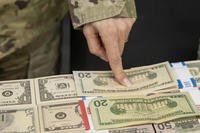
Last week, the bank called to say that they believed that my husband's credit card information had been compromised. They were wrong, thankfully, but it got me thinking about my credit cards and their security. Fortunately, there are easy steps that you can take to minimize the chance that your credit card information will be stolen and used. There are many ways that identity theft can occur, but for this post I'm going to focus on credit cards.
Photo by: Popstencil
- Empty out your wallet and only put back the things that you need. I carry one credit card and one debit card. I'd notice pretty quickly if anything was missing! If you have physical cards for accounts that you never use (and won't use), you might want to destroy the cards. You can always get replacements if your plans change.
- Make a photocopy of the front and back of your card. If you use the enlarge option, you'll be able to read the information clearly on the copies. Lock them someplace secure. Make a list of the customer service numbers for all your accounts
- Go paperless - receive and pay bills electronically to prevent the possibility of your mail being stolen.
- Pick up your mail daily, consider buying a locking mailbox, or use a post office box. Know roughly when your bills should come and call the issuer if you don't receive it when expected. Get to know your mail carrier, and contact the post office if you don't receive any "real" mail for a few days.
- Be vigilant at ATM machines and Point of Sale (POS) debit machines in stores. It is often very easy to see people putting in their PIN numbers.
- Check your credit report, at least annually, and be sure to check with all three major credit reporting agencies (Experian, Transunion, and Equifax.) Use AnnualCreditReport to obtain your credit report as it is the correct way to get it for free, without going through any outside companies or signing up for any services.
- Sign your credit card. I know how tempting it is to write "SEE ID" in the signature block, and the logic seems sound. However, the agreement between the credit card company and you requires that you sign the card, and the agreement between the merchants and the credit issuers requires that the merchant verify a signature. The merchant is not really supposed to accept the card if it isn't signed, but they can allow anyone (even a thief) to sign the card in front of them. In addition, the merchant isn't technically allowed to refuse to process a transaction based upon the customers ability or desire to present additional identification. If you are living or traveling overseas, merchants seem to be much more serious about not accepting unsigned credit cards.
- Keep your receipts and match them to your statements. (I'm terrible about this.) Stick a basket in a drawer, the corner of your desk or on a bookshelf to keep them together until the bill comes in. Check your online statement regularly. It is a lot easier to remember transactions if you don't wait for the entire month's bill to review.
- If you rent a car, be sure to remove the rental contract from the glove
box when you return the car. It contains a lot of personal information. - If you can't find your card, report it missing immediately. Don't wait for it to turn up, or waste time looking for it. If you find it, you can call back and have it reactivated, or wait a day or two for the new card to come. The faster you report a card missing, the better the chances of preventing someone else from using it.
I'm pretty sure that number 10 is the most important thing, but combined these tips can minimize the hassle of credit card theft and fraud. Happy shopping!








